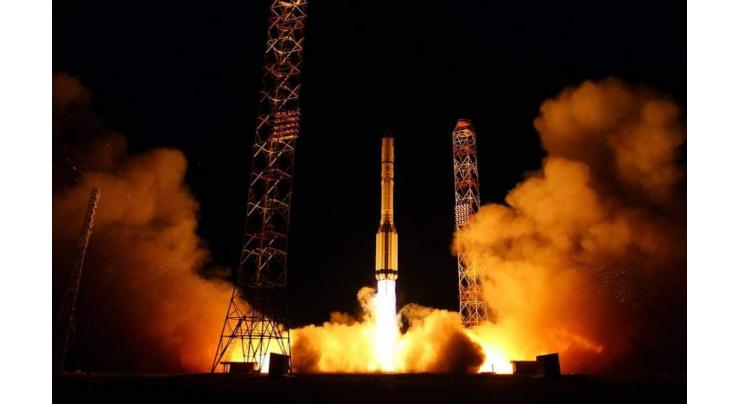
- Home
- Technology
- News
- Russia's Proton-M Carrier With 2 Foreign Satellites Launched From Baikonur Spaceport
Russia's Proton-M Carrier With 2 Foreign Satellites Launched From Baikonur Spaceport
Daniyal Sohail Published October 09, 2019 | 04:42 PM

Russia's Proton-M heavy-class carrier rocket, carrying the European Eutelsat 5 West B communications satellite and the US Mission Extension Vehicle-1 satellite refueling spacecraft, was launched from Baikonur spaceport on Wednesday, with the process being broadcast on the website of Russian State Space Corporation Roscosmos
MOSCOW (UrduPoint News / Sputnik - 09th October, 2019) Russia's Proton-M heavy-class carrier rocket, carrying the European Eutelsat 5 West B communications satellite and the US Mission Extension Vehicle-1 satellite refueling spacecraft, was launched from Baikonur spaceport on Wednesday, with the process being broadcast on the website of Russian State Space Corporation Roscosmos.
According to Roscosmos, the Breeze-M upper stage, carrying the satellites, will separate from Proton-M's third stage in around 10 minutes after the launch on a suborbital trajectory.
Taking the satellites to orbit will take record-long almost 16 hours. The Eutelsat 5 West B is expected to separate from the upper stage on October 10, at 4.54 a.m. Moscow time (01:54 GMT), while the Mission Extension Vehicle-1 is expected to separate shortly after, at 5.12 a.m. Moscow time.
This is Russia's 19th space launch and the fourth Proton-M launch in 2019.
The launch was initially scheduled for September 30, but then delayed for conducting additional tests of Breeze-M's control system.
The Eutelsat 5 West B, with its launch mass totaling 2,864 kilograms (6,314 Pounds), has been produced by Airbus Defence and Space и Northrop Grumman for the Eutelsat satellite communications company. It is expected to work on the geostationary orbit for 15 years, providing telecommunications services on the territories of France, Italy and Algeria.
The Mission Extension Vehicle-1, with its launch mass totaling 2,326 kilograms, has been produced by Northrop Grumman for its subsidiary SpaceLogistics. Its lifespan is expected to reach 15 years. The spacecraft will be working on expanding the lifespan of satellites operating on the geostationary orbit. Due to being refueled by the Mission Extension Vehicle-1, the Intelsat 901 will be able to extend its mission by 5 years.
The Proton expendable launch system has been in use since 1965. Its latest model, the Proton-M, has been used since 2001.
Recent Stories

Mired in crisis, Boeing reports another loss

Session Awarding Ceremony 2024 held at Cadet College Muzaffarabad

Austrian ski great Hirscher to make comeback under Dutch flag

Pakistan, Japan agrees to convene 'Economic Policy Dialogue'

FM Dar conveys deepest sympathy on torrential rains devastation in UAE

Spain PM Sanchez says weighing resignation after wife's graft probe

Tennis: ATP/WTA Madrid Open results - 1st update

Long-lost Klimt portrait auctioned off for 30 mn euros

Osaka seals first win on clay since 2022 in Madrid

Earthquake jolts Karachi

Sindh minister orders operation after attack on police in Ghotki

TikTok to fight US ban law in courts
More Stories From Technology
-

Punjab CM inaugurates Pakistan’s first Virtual Women Police Station
1 day ago -

Pro Tips: How to Capture Stunning Portraits with the Aura Light Portrait of vivo V30 5G
2 days ago -

Itel celebrates launch of S24—a new brand identity
3 days ago -

Realme C53 Price Slash: High-Tech Meets High Style at New Low Price!
4 days ago -

Take Charge, Live Free: Empower Your Life with Infinix NOTE 40 Series
6 days ago -

PTA Undertakes Consultation with All Pakistan Network Association (APNA) on Proposed Class Value Add ..
6 days ago
-

Vivo V30 5G: The Perfect Blend of Enhanced Photography and Premium Design
7 days ago -
PITB's Regional Plan 9 invites applications for its newly launched incubation centers in Rawalpindi, ..
8 days ago -

Pakistan calls for enhanced information integrity on digital platforms
9 days ago -

Infinix NOTE 40 Series vs. the Competition: Why It Stands Out
9 days ago -

"Unlock Exceptional Value: The New realme Note 50 with Extended Warranty Now Available in Pakistan!� ..
9 days ago -

Google unveils new AI chips, arm-based processor for data centers
15 days ago










